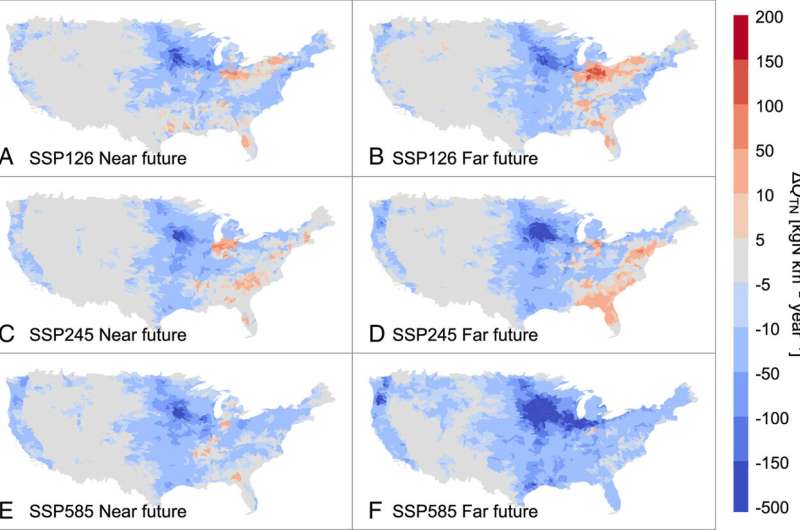This article has been reviewed according to Science X's editorial process and policies. Editors have highlighted the following attributes while ensuring the content's credibility:
fact-checked
peer-reviewed publication
trusted source
proofread
Nitrogen runoff strategies complicated by climate change

As climate change progresses, rising temperatures may impact nitrogen runoff from land to lakes and streams more than projected increases in total and extreme precipitation for most of the continental United States, according to new research from a team of Carnegie climate scientists led by Gang Zhao and Anna Michalak published in the Proceedings of the National Academy of Sciences.
The conditions predicted by these findings are opposite to recent decades, in which increasing precipitation has outpaced warming and led to more aquatic nitrogen pollution. Understanding the relative roles of changes in temperature and rainfall is critical for designing water quality management strategies that are robust to climate change while ensuring sustainable food and water supplies.
Human activity has completely altered how nitrogen moves through the planet's aquatic, terrestrial, and atmospheric systems. Nitrogen from fertilizer washes into waterways, and in excess, can lead to toxin-producing algal blooms or low-oxygen dead zones called hypoxia. Over the past several summers, large algal blooms in lake and coastal regions across the United States have received extensive news coverage.
Carnegie's Anna Michalak and her team have spent the last decade studying how climate change will affect nitrogen runoff and the subsequent risks posed to water quality. One of the biggest questions for those working to understand and prevent serious water quality impairments is the balance between how changes in temperature and changes in precipitation will affect nitrogen pollution's ability to get into at-risk waterways.
"The complex soil and aquatic systems through which nitrogen travels, the chemical transformations it undergoes along the way, and the various ways in which changes in temperature and precipitation will affect these processes make nutrient management a big challenge," Zhao explained.
For example, average and extreme precipitation affects how much nitrogen runs off the land and into waterways, as well as how long it takes for the nitrogen to reach lakes or coastal zones, where it can eventually create dangerous conditions. Temperature also indirectly impacts how much nitrogen ends up in waterways, because warming temperatures increase evaporation, preventing it from going into streams. Additionally, temperature affects how nitrogen interacts with microbial life in the soil and sediment, potentially trapping it there or altering its course.
"Although the impacts of climate change-induced shifts in precipitation patterns have been explored, the effect of temperature increases on the movement of nitrogen into rivers has not been quantified at continental scales until now due to a lack of available data," Zhao added.
Zhao, Michalak, and their Carnegie colleagues Julian Merder and Tristan Ballard analyzed several decades of data tracking nitrogen's movement through river systems across the continental United States and used it to project future trajectories for nitrogen movement under climate change scenarios. They determined that rising temperatures will likely offset—or even decrease—the amount of excess nitrogen flushed into rivers for the majority of the U.S., despite a predicted uptick in precipitation.
These findings are counter to recent decades, when precipitation was the dominant factor over temperature in determining the amount of nitrogen that built up in U.S. waterways. Zhao, Michalak, and their colleagues say that this work forms a critical baseline for future research on the interplay between the nitrogen cycle and climate change.
"Our research illustrates the complex and sometimes surprising ways that climate change affects our planet's dynamic systems," Michalak concluded. "Untangling the various factors that are altering the climate change impacts on water quality will help farmers, land managers, and policymakers to pursue the best possible strategies for ensuring that we safeguard water quality, while simultaneously ensuring sustainable food production and water supply."
More information: Gang Zhao et al, Warming may offset impact of precipitation changes on riverine nitrogen loading, Proceedings of the National Academy of Sciences (2023). DOI: 10.1073/pnas.2220616120
Journal information: Proceedings of the National Academy of Sciences
Provided by Carnegie Institution for Science





















